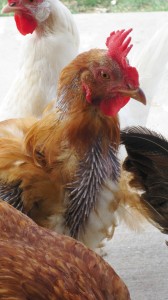We’ve been having fun trying to gather all the fruit on the property. The most obvious to try and collect are the coconuts…but they are also the hardest to get and to open. Here’s a video of Britton versus the coconut (and mango).
Category Archives: food plants
Sterling and Northeastern Colorado
I had to do some work out in Northeastern Colorado. So after I got done with my work, Britton and I were able to hang out in the Sterling, CO area. Sterling is about 100 miles away from Greeley. It is such a strange place. Going there was almost like traveling in a time machine. Everything seemed outdated and like we were revisiting the 80’s. From the music on the radios to the furnishings and style of the hotel, everything around you made you think you’d stepped back in time.
Northeastern Colorado is more like Kansas and Nebraska than what most people would first think of when they think Colorado. For people who are unfamiliar with Colorado, the first thing they think of is skiing and the mountains, which is half our state. The other half is prairie lands. For hundreds of miles it is nothing but sage brush and tumbleweeds. If you drive from Nebraska into Colorado, you wouldn’t even see the mountains in the distance until you hit Greeley -and some of them are 14,000 feet high!
So going out there was quite the experience. Driving is a breeze, if anything it can be too monotonous and boring as there are few cars and few turns. Here are a few pictures (click to enlarge) of our mini-adventure to Sterling and into Northeastern Colorado to give you a feel for the area:

Lots of Windmills -many were functional to water cattle

A long neglected weathered old barn on the other side of the railroad tracks

The biggest variation in topography were a few softly rolling hills
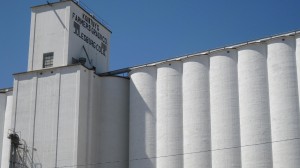
Huge Grain Silos show what most people do out there

All the chemical fertilizers used in the (conventional) farming have caused some unwanted consequences, such as nitrates in the water. This can cause major health problems, especially for what they call “blue babies”.
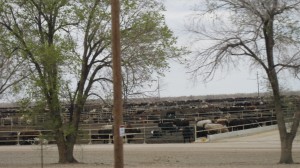
A huge feedlot outside of Greeley near Kersey
Raising cattle and bison makes a lot of sense out on this dryland prairie because they will eat the dry grasses that nothing else can. However this easy solution -grazing animals on acres of grassland- is turned into a problem when condensed into feedlot operations where all the waste is concentrated. In the olden days, cowboys were used to round up the cattle on these grasslands. Now they have shifted into this feedlot system instead. This requires extensive feed inputs in the form mainly of (subsidized) corn. Corn, unlike this prairie grassland, is highly water intensive. The close proximity of the animals and the fact that they are standing in their waste also causes them to get sick more often. So, they are given prophylactic antibiotics in their feed, which in turn the general public soon eats.
With all the open space out here in Northeastern Colorado and little rainfall, using this water-intensive and condensed system seems completely counter-intuitive. This un-natural, and ultimately unhealthy system only runs on food (corn) subsidies and (cheap) petroleum. If you ask where all the real cowboys have gone, here’s your answer.

Long ribbons of empty road unfold in front of you
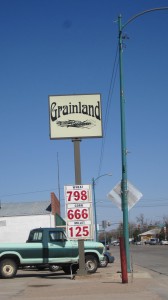
Grain prices -wheat, corn, millet

This bumper sticker is reflective of the thoughts on beef in this region: Eat Beef: The West wasn’t won on salad.

A visual reminder that all of this is currently possible only because of fossil fuels. It will be interesting to see how agricultural areas like Northeastern Colorado adapt -or possibly revert back to the tried and true ways- when fuel prices rise
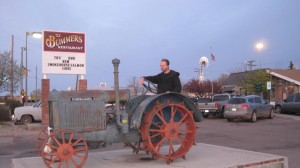
We went out to eat at a place in Sterling called TJ Bummers. They had lots of old antiques including this old tractor out front. It reminded us of the way it must have been out here in the wild west days.
Overall, it was a nice trip. Going to Northeastern Colorado is not generally thought of as a destination in Colorado, but it is a reminder of what a large part of Colorado is all about. Agriculture is a vital part of our Colorado economy and if you ever want to see that up close and personal, this is the area you should visit.
This feedlot is huge
Puerto Rico…A Little Closer
Today we got a little closer to Puerto Rico. (At least figuratively, but perhaps actually since the earth moved a little off its axis after that huge earthquake in Japan.)
We applied for and were approved for two personal loans that will help to cover the difference in buying the place in Rincon. We have also bought our tickets to Aguadilla and back leaving the last week in May and returning early June (2 weeks). And thanks to the kind Kruses, I think we have a place to stay when we first arrive. I am so excited today that I just want to do it now! But I know we must wait, and so I have been keeping myself calm by reading all about the tropical plants we can grow there!
I picked up one from the library called Growing Tasty Tropical Plants. I am ready to grow, cook with, and eat kumquats, guava, cinnamon, yerba mate, passion fruit, dragon fruit, and miracle berries among many other strange and delectable things. Hurray for gardening in the tropics! And hurray for all these steps that are helping our dream bear fruit as well.
Fall, Freezes and Feathers
We had a pretty hard freeze the other night and so all our beautiful flowers out front, our basil, peppers and tomatoes all just turned black and shriveled up into a mess. The same thing happened in our greenhouse. We also had some horrendous winds and so most of the yellow and red leaves have blown off the trees. Still, in true Colorado fashion the weather shifts between mid 70s to 30s depending on the day.

Front after the freeze…all withered and wilted
The chickens have been laying a lot fewer eggs and Henrietta started molting which means no eggs from her at all until that’s done. Some people put a light in their coops for about an hour at night to increase their laying, but we don’t. We figure it’s a good time for them to rest and follow nature’s rhythms. I know that I want to sleep a lot more too!
Pretty soon we will be moving them into their winter home: the greenhouse. After the freeze I went in there to check it out and so did they. They helped clean it up by eating some of the over-ripe tomatoes for us. Also, don’t miss Kitty’s cameo



